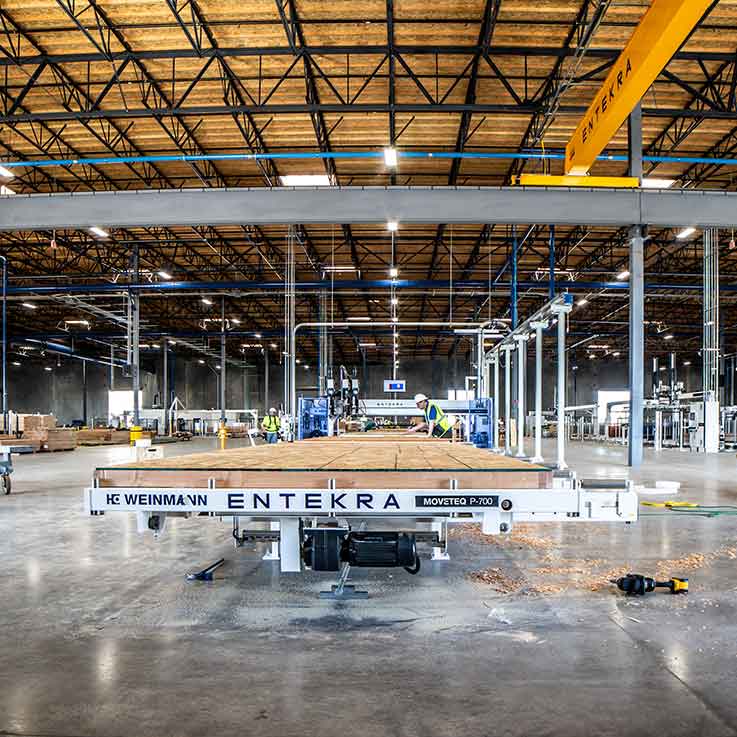
Innovative Solutions for the Housing Crisis
Innovative Solutions for the Housing Crisis
Six pathways to making housing more affordable and available from the Ivory Prize for Housing Affordability.
By Abby Ivory & Kent W. Colton Dec. 1, 2020
(Photo courtesy of Ivory Innovation)
The nation is experiencing a major housing shortage coupled with a crisis of housing affordability. “New housing supply is not keeping pace with rising demand,” warns Sam Khater, Freddie Mac’s chief economist, citing a shortage of about 300,000 units a year. And innovation can have a significant impact. But as Matt Ridley recently stressed in the Wall Street Journal, we need to rethink the incentives for innovation, “to expand the use of prizes, to replace the reliance on grants, subsidies, and patents.” Prizes provide the opportunity to identify innovations that are already underway, as well as recognizing creative successes that can be expanded or repeated by others. To this end, the Ivory Prize for Housing Affordability was established in 2018 to advance projects and reward innovators for their efforts to develop affordable solutions to tackle housing affordability.
Through the Ivory Prize, significant innovation and creativity have been identified: Not one solution, but a number of solutions are emerging, with a great deal of energy and creativity at the grassroots level. Based on the innovation underway and recognized through the Ivory Prize process, this article will highlight six innovative paths that will help us move towards affordability in housing.
1. Removing Regulatory Barriers at the Local, State, and Federal Level to Allow More Homes and Apartments to Be Built and Reduce the Time and Cost of Building
If the nation, and state and local communities, are going to make significant progress in addressing housing affordability, one of the key policy levers is to reduce or remove regulatory barriers to building new homes and apartments. Work is underway in the private sector and the public sector to achieve better regulatory policies for housing affordability.
An excellent example of private sector innovation is Symbium, located in San Francisco, which has developed a computational law platform that mechanizes the rules and regulations of a planning code, to help homeowners, design professionals, and planners quickly determine if an Accessory Dwelling Unit (ADU) is allowed on a property. Automating the legal analysis for the planning code enables anyone to access what is possible in a certain jurisdiction or on a given parcel, and it reduces the processing time from multiple months or weeks to an immediate response. This kind of computational capacity is an important breakthrough in reducing the administrative and regulatory barriers, and demonstrates the potential for other processing innovations related to planning and zoning.
In the public sector, the City of Minneapolis and the State of Oregon have made important steps to break down the regulatory barriers to housing affordability by essentially eliminating single-family zoning. While nearly 75 percent of the housing in Minneapolis was previously zoned single-family, now, up to three units are allowed on any residential plot of land throughout the entire city. “By rezoning lots that currently accommodate only one single-family house to allow duplexes and triplexes,” says Andrea Brennan, Minneapolis’s Housing Policy and Development Director, “Minneapolis effectively triples the housing capacity of some neighborhoods.”
In Oregon, the state legislature passed HB2001 in June 2019, with bipartisan support, historic legislation that effectively ended single-family zoning in the state. States hold the legal authority to establish the parameters for zoning at the local level, and the State of Oregon has made a bold move to assert that authority to encourage local jurisdictions to allow more housing to be built in their state.
2. Innovation to Build Faster, Increase Productivity, and Lower Costs
Entekra, located in California and focused on off-site framing, focuses on increasing home building productivity and reducing time and costs. Stick-built framing of a typical 2,500-square-foot house generally takes a crew of five workers about 15 days (71 man-days) to complete, but with Entekra’s Fully Integrated Off-Site Solution (FIOSS) and a crane, the framing can be accomplished in just four days by a crew of four (14 man-days). This represents a productivity increase of more than 500 percent and reduces total build time by an average of 30+ days, with estimated savings for each house up to $25,000. FIOSS also contributes to a reduction in errors and reduces on site skilled labor needs.
In the area of multifamily housing, FullStake Modular, located in New York City, merges modular housing with new construction technologies to bring a higher level of control, predictability and scalability to multifamily development. FullStack Modular built the modules for 461 Dean Street in Brooklyn, New York, which is the tallest modular building in the world, with 33 stories and 363 units. They use structural frames to build each of their units and verify that all tolerances are within 0.25”.
New technologies are also contributing to the effort to fight homelessness. For example, New Story Charity, based in San Francisco, has built more than 2,700 homes globally, affecting 12,000 lives, in part by partnering with a company called ICON in Mexico to use 3D printing to drive down costs.
3. Creative Finance to Allow More People to Qualify for a Mortgage and Buy a Home, and to Provide More Affordable Rental Housing
Rhino, located in New York City but licensed to operate in all 50 states, partners with building owners and managers to offer low-cost insurance as an alternative to cash security deposits. When a renter inquires about a unit where Rhino is an option, they can choose between low-cost insurance or a traditional security deposit, and the transaction is made directly with the renter. The renter receives information about the premium immediately, and then they can decide whether to pay the premium in lieu of a security deposit. The cost of insurance varies but tends to average between $4-7/month.
Several companies have developed “crowdfunding” approaches to help future home buyers and to seek investors. For example, HomeFundIt in Baltimore, Maryland, is an online crowdfunding platform that allows home buyers to use gifts from family and friends for the down payment on a home. Using a different approach, Small Change in Pittsburgh connects investors with developers to build better cities. On Small Change, anyone over the age of 18 can invest in affordable housing projects, community-centric projects, transit-oriented projects, and projects that make better places for everyone.
4. Assist Renters to Improve Their Financial Position and Credit Scores to Help Them Achieve Homeownership
Renters face a number of financial and other barriers, especially minorities and those with lower incomes, and overcoming these barriers is one of the essential paths to housing affordability. Till, located in Alexandria, Virginia, has established a platform that transforms a renter’s ability to pay, stay, and thrive in their home by using real-time data to develop payment solutions to address their needs. These personalized structures reduce the avoidable costs of delinquency and eviction. In addition, as rent is often a renter’s largest household expense, Till helps to drive meaningful improvements across a renter’s entire financial landscape.
Less than 1 percent of credit reports include rent, yet for many people it is their largest and most consistent payment. ESUSU, which is located in New York City, offers a rental data reporting service that includes rent as a factor of credit scores. This reporting service builds credit reports for renters by partnering with property managers and public housing authorities or working directly with landlords. That renters have not received credit for their payment history prevents many low-to-moderate income renters from qualifying for a mortgage, or qualifying for a higher-priced home. By using rent payment data to establish creditworthiness, ESUSU can dramatically lower the cost-of-capital for a renter who becomes a homeowner.
5. Using Existing Housing and Land to Provide Greater Housing Opportunities
One way to accommodate the unmet housing demand is to better utilize existing housing and land. Starcity, located in San Francisco, is an owner, operator, advocate, and builder of co-living communities with a mission to make great cities accessible to everyone. They accomplish this by creating comfortable community homes that inspire people to live what they feel is a more intentional life. In Boston, Nesterly has developed an innovation that tackles two big housing affordability challenges with one solution, connecting senior households and students. Students are looking for affordable places to live while they are going to school in the Boston area and senior households have homes and space but need additional income to live and pay their expenses. Nesterly provides an electronic platform that matches the students with the senior citizens, and the added benefits are often companionship for the seniors and friendly support for the students.
Another example is Accessory Dwelling Units (ADUs) built on the lot of a new or existing home. The Casita Coalition in San Francisco fills a unique need in California by encouraging the construction of small homes, such as ADUs, throughout all types of neighborhoods. In addition, the City of Boston provides gap funding for those approved for an ADU through a zero-interest loan, which have no monthly payment until the owner either sells or refinances.
6. Preserve and Produce Affordable Housing in Neighborhoods, Building on the People and Strengths of That Community
Century Partners in Detroit, Michigan is noted for their work to help revitalize the neighborhoods on Detroit’s northwest side through renovation, new construction, the provision of green infrastructure, and creative work with the community. They have hired more than 40 neighborhood residents to perform lawn maintenance, demolition, and eventually construction rehabilitation.
ROC USA, located in Concord, has worked over the past decade to convert mobile home parks to resident-owned communities in 17 states nationwide. ROC USA, LLC is a nonprofit social venture with a mission to make quality resident ownership viable nationwide (generally for lower-income families or individuals) and to expand economic opportunities for homeowners in manufactured (mobile) home communities. As a cooperative non-profit business, ROC USA targets lower-income people who live in mobile home parks and helps the residents with financing and technical assistance to purchase and then successfully manage their own manufactured home park as a co-op or Resident Owned Community (ROC). A recent Freddie Mac study on Resident Owned Communities found that: “ROCs are one of the few sources of unsubsidized naturally occurring affordable housing in the country not subject to market-based rent increases.”
Focus on the Solutions, Not the Problem
There are no simple nationwide solutions to housing affordability, but it’s a mistake to spend all our time talking about the problems. With the focus on solutions and innovation, it is possible to identify marvelous creativity at the “grassroots level” which is already underway throughout the country. As we recognize the innovation that is in progress, it helps highlight the directions and paths that should be followed to improve housing affordability.










